Discover one of Vietnam’s most captivating spiritual sites – Bai Dinh Pagoda. Known for its massive scale, serene atmosphere, and rich heritage, Bai Dinh Pagoda is a blend of both ancient and modern architectural wonders. Join Pioneer Sail Travel on this journey as we highlight what makes Bai Dinh Pagoda a top cultural attraction in Southeast Asia.
Bai Dinh Pagoda and Its Significance
Situated in Ninh Binh province, Bai Dinh Pagoda is the largest pagoda complex in Vietnam, and it ranks among the most significant spiritual destinations in Asia. Spanning over 700 hectares, this monumental complex boasts ancient relics, bronze Buddha statues, and a vast network of temples that represent Vietnamese Buddhist heritage.

A visit to Bai Dinh Pagoda offers insight into Vietnam’s rich traditions and impressive architecture. Walking through its serene pathways and statues, visitors encounter a harmonious blend of peace and grandeur, unique to this revered site.
Quick Facts about Bai Dinh Pagoda:
- Location: Gia Sinh, Gia Vien, Ninh Binh, Vietnam
- Total Area: 700 hectares
- Largest Statue: A bronze Buddha statue weighing 100 tons
- Annual Visitors: Welcomes over 5 million visitors each year (according to a 2021 report by Ninh Binh Department of Culture)
Bai Dinh Pagoda’s grandeur reflects the devotion, artistry, and dedication of the Vietnamese people to Buddhism, making it a must-visit for travelers and pilgrims alike.
Historical and Spiritual Background of Bai Dinh Pagoda
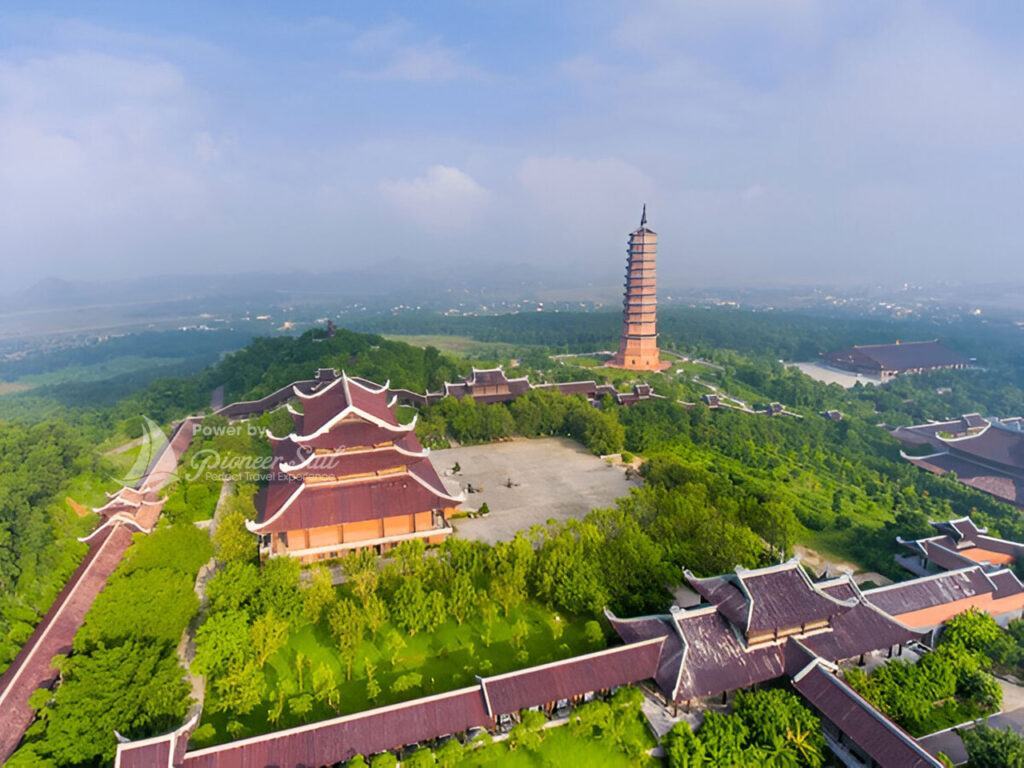
The Origins and Development of Bai Dinh
Bai Dinh Pagoda’s origins date back over a thousand years, rooted in the reign of Emperor Ly Thai To in the 11th century. The original complex, known as Ancient Bai Dinh, was built high on Bai Dinh Mountain and later expanded into the grand complex we see today. Ancient Bai Dinh served as a secluded retreat for monks and a hub for Buddhist practice.
- Ancient Bai Dinh: Originally established by the venerated monk Nguyen Minh Khong, the ancient pagoda stands as a testament to early Vietnamese Buddhism and reflects the simple yet profound spirituality of the time.
- Modern Bai Dinh: Inaugurated in 2010, the modern Bai Dinh Pagoda was part of a national project aiming to revive and honor Vietnamese cultural heritage. This new development cost an estimated $70 million, funded by both private and public contributions, and attracts pilgrims and tourists from across Asia.
The coexistence of these two complexes, old and new, provides a fascinating journey through Vietnam’s spiritual history, creating a unique duality in Bai Dinh’s identity.
Notable Figures in Bai Dinh’s Legacy
- Nguyen Minh Khong: Credited with founding the ancient Bai Dinh, monk Nguyen Minh Khong is remembered as a central figure in Vietnamese Buddhism, known for his healing abilities and deep spirituality.
- Emperor Ly Thai To: As one of the country’s most influential rulers, Ly Thai To promoted Buddhism as a guiding national philosophy, supporting the establishment of Bai Dinh as a major religious site. His legacy solidified the spiritual and historical importance of Bai Dinh in Vietnamese culture.
Cultural and Religious Importance in Vietnam
Bai Dinh Pagoda holds a revered place in Vietnamese Buddhism, serving as a central pilgrimage destination and a symbol of the Vietnamese people’s dedication to their spiritual beliefs. Each structure within the complex represents various Buddhist teachings, from compassion and selflessness to enlightenment.
- Buddhist Symbolism: The layout of Bai Dinh Pagoda, from its pathways to the statues and stupas, represents the path toward enlightenment and inner peace. The imposing Buddha statues exemplify Buddhist values such as compassion, wisdom, and strength.
- Vietnamese Traditions and Practices: Bai Dinh is an essential site for observing Vietnamese Buddhist practices, hosting numerous annual celebrations. Notably, the temple is central to the annual Vesak festival, a major Buddhist holiday commemorating Buddha’s birth, enlightenment, and death.
Through its detailed architecture, elaborate statues, and spiritual activities, Bai Dinh Pagoda embodies the spirit and cultural heritage of Vietnamese Buddhism, making it a place of both local devotion and international admiration.
Architectural Highlights of Bai Dinh Pagoda
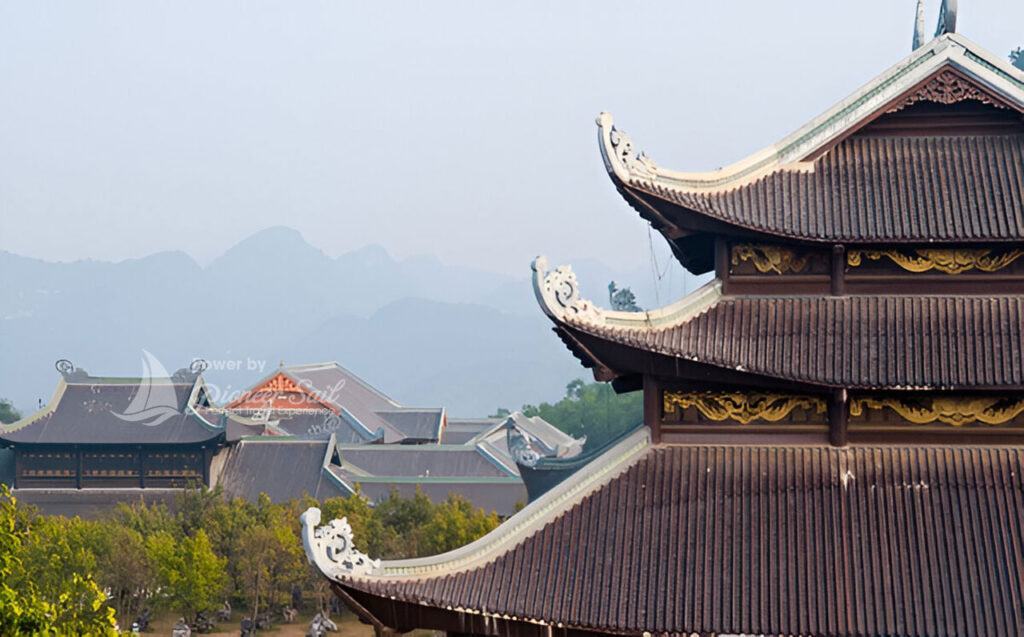
Unique Design and Layout
Bai Dinh Pagoda is an architectural masterpiece, combining traditional Vietnamese design elements with modern grandeur. The complex is home to several impressive structures, including towers, statues, and walkways, all spread across 700 hectares. The meticulous design captures the essence of Vietnamese culture, featuring classic materials like terracotta tiles, stone carvings, and intricately crafted wooden beams.
One of the most unique aspects of Bai Dinh Pagoda is its layout, which invites visitors to journey through various sections that represent stages of spiritual growth. The primary path leads through multiple courtyards, each decorated with carefully positioned statues, symbolic of the virtues within Buddhist teachings. This layout symbolizes the spiritual journey from earthly challenges to enlightenment, offering an immersive experience for both Buddhists and visitors.
Interesting Fact: Each of the pagoda’s pathways contains lines of stone-carved Arhat statues, representing Buddhist figures from scriptures. With over 500 individual statues, Bai Dinh holds a record in Vietnam for having the most Arhat statues within a single complex.
Key Structures and Sacred Highlights
- The Giant Buddha Statues
Among Bai Dinh’s most iconic features are the massive bronze Buddha statues. The largest, standing at an astonishing 10 meters and weighing over 100 tons, is a symbol of both spiritual and artistic accomplishment. Crafted by Vietnamese artisans, these statues emphasize the skill and dedication invested in the site, making it one of the largest collections of bronze Buddha statues in Asia. - Stupas and Bell Towers
The main bell tower of Bai Dinh Pagoda houses a massive bronze bell weighing around 36 tons. This bell is ceremonially rung during important Buddhist events and festivals. The pagoda’s stupa, towering at nearly 100 meters, stands as a symbol of Bai Dinh’s ambition to connect Vietnamese and Buddhist heritage. Each level of the stupa offers visitors a new perspective on the sprawling Ninh Binh landscape, creating an atmosphere of peace and reflection. - The Bodhi Tree Garden
Inspired by the legendary Bodhi tree under which the Buddha attained enlightenment, the Bodhi Garden in Bai Dinh Pagoda contains saplings sourced from Bodh Gaya, India. Each tree is marked with a plaque detailing its significance, creating a profound experience for Buddhists who seek to connect with this sacred history.
Must-See Attractions at Bai Dinh Pagoda
The Hall of Arhats
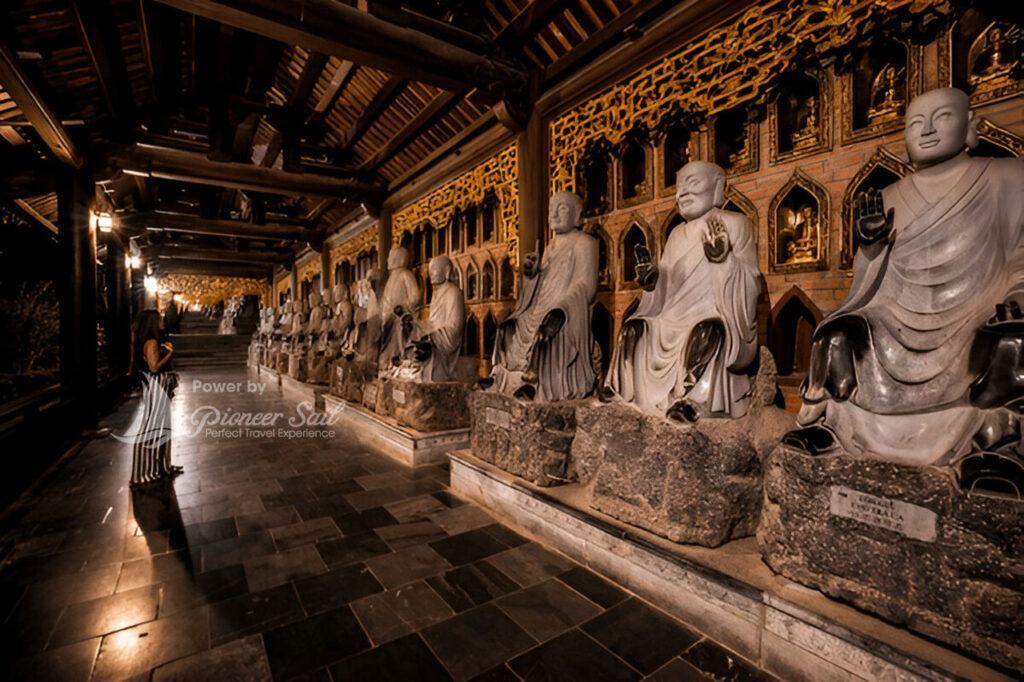
The Hall of Arhats is one of the most famous areas within Bai Dinh Pagoda. With over 500 life-sized Arhat statues, each uniquely crafted, the hall serves as both a pilgrimage site and an art display. Each statue embodies specific virtues and spiritual teachings, offering insights into Buddhist philosophies. Visitors often walk along the hall in reflection, observing the fine details and individual character of each Arhat.
Tip for Visitors: To fully appreciate the detail of the Arhat statues, visit early in the morning or later in the evening when the crowds are thinner. This quiet period also allows for better photo opportunities.
Temple of the Three-Gate Entrance
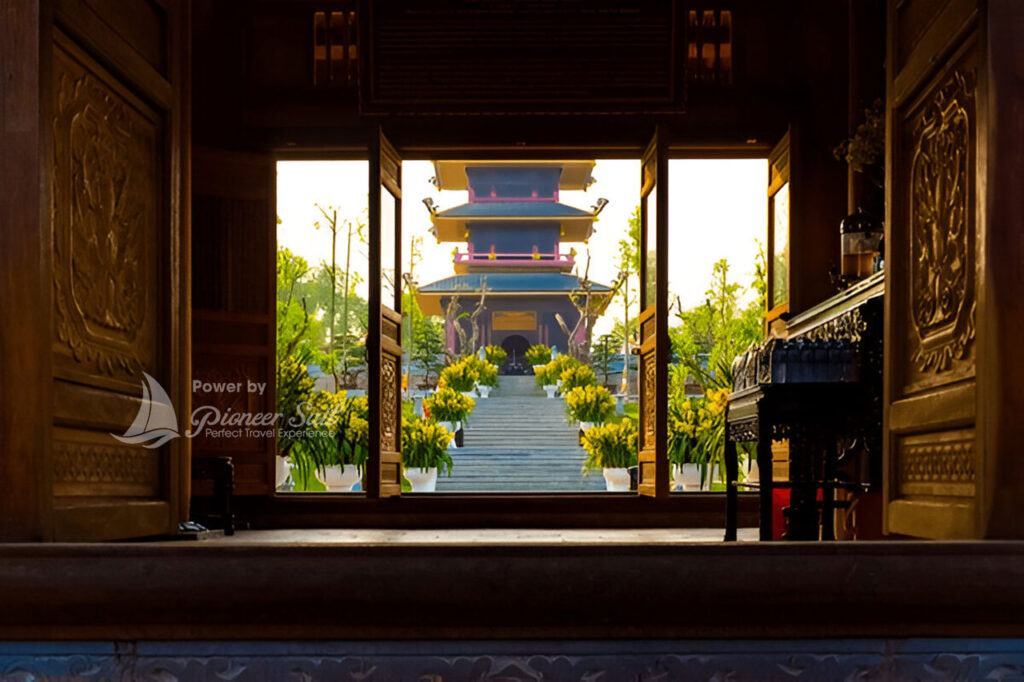
As visitors approach Bai Dinh, the grand Three-Gate Entrance is among the first monumental sights they encounter. This triple-arched gateway symbolizes the three gates of Buddhist practice: compassion, wisdom, and meditation. Passing through this entrance, visitors leave behind the material world and step into a spiritual realm.
The Dining Experience at Bai Dinh Pagoda
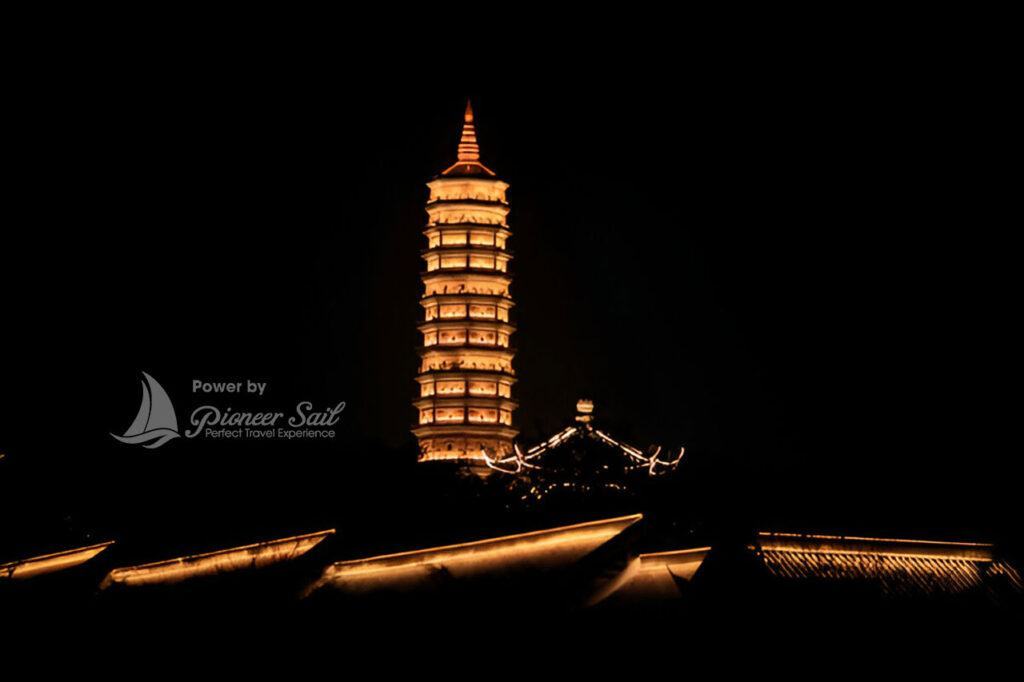
Food is an important part of the Bai Dinh experience, with various vegetarian dining options available within the temple grounds. Traditional vegetarian dishes, made from local ingredients, are served to reflect Buddhist principles of non-violence and respect for all living things. Visitors are encouraged to enjoy a meal at the temple’s dining halls, where they can sample specialties such as vegetarian pho, banh bao (steamed buns), and lotus seed porridge.
Interesting Note: Every year, during the Lunar New Year festival, Bai Dinh Pagoda hosts a vegetarian food festival. This event celebrates Buddhist culture through culinary arts, drawing thousands of visitors who wish to sample traditional vegetarian dishes.
Visitor Tips for Exploring Bai Dinh Pagoda
Best Times to Visit
Bai Dinh Pagoda is open year-round, but the ideal time to visit is during the spring festival season, especially during the Lunar New Year and the Bai Dinh Pagoda Festival, which takes place from the first to the third lunar month. During these festivals, visitors can witness traditional ceremonies, local performances, and Buddhist rituals that provide a richer cultural experience.
- Peak Season: February to April, during the Bai Dinh Pagoda Festival.
- Quiet Times: Early morning hours on weekdays offer a peaceful atmosphere with fewer tourists.
Traveler’s Tip: For an immersive experience, join a guided tour during the Bai Dinh Pagoda Festival. These tours provide background on the temple’s history, architecture, and cultural significance, enhancing your visit.
Travel Tips and Etiquette
- Dress Code: Modest attire is required. Visitors should wear long pants and cover their shoulders when entering the temple.
- Photography: Photography is generally allowed; however, be respectful and avoid taking photos during worship.
- Guided Tours: English-speaking guides are available for hire at the entrance, offering detailed insights into the site’s history and Buddhist teachings.
Pro Tip: To cover the entire complex comfortably, allocate at least half a day. The pagoda grounds are vast, so comfortable walking shoes are essential.
Why Bai Dinh Pagoda is a Must-Visit in Vietnam
Bai Dinh Pagoda is not only a testament to Vietnam’s deep-rooted Buddhist culture but also a symbol of national pride and spiritual identity. From its awe-inspiring architecture to its sacred statues and tranquil gardens, the pagoda offers visitors a profound experience unlike any other in Southeast Asia. Whether you’re on a spiritual journey, exploring Vietnam’s history, or simply seeking tranquility, Bai Dinh Pagoda promises an unforgettable experience.
Introduce about Bai Dinh Pagoda as a key destination on your next trip to Vietnam, and experience a site where spiritual history and cultural heritage come together to create something truly magical.
FAQs
- What makes Bai Dinh Pagoda a unique destination in Vietnam?
Bai Dinh Pagoda is Vietnam’s largest pagoda complex, featuring over 700 hectares of temples, statues, and spiritual spaces. Its mix of ancient and modern architectural styles, massive Buddha statues, and over 500 Arhat statues make it one of Asia’s most fascinating Buddhist sites. - When is the best time to visit Bai Dinh Pagoda?
The best time to visit Bai Dinh Pagoda is from February to April, coinciding with the Bai Dinh Pagoda Festival, which offers a vibrant cultural experience with traditional ceremonies and Buddhist rituals. Early mornings during weekdays are also great for a quieter visit. - Is there an entrance fee for Bai Dinh Pagoda?
Yes, while entry to the general grounds is often free, there may be a small fee for guided tours or specific attractions within the complex, such as the bell tower or the main pagodas. - How long should I plan to spend at Bai Dinh Pagoda?
Given its size, plan at least half a day (4–5 hours) to fully explore Bai Dinh Pagoda. If you wish to experience all sections or participate in festivals, a full day would be ideal. - Are there dining options available at Bai Dinh Pagoda?
Yes, Bai Dinh Pagoda offers several vegetarian dining options that align with Buddhist practices, such as vegetarian pho, steamed buns, and lotus seed porridge. Special dining halls and food stalls are available within the complex.
Tags:
introduce about Bai Dinh Pagoda, Bai Dinh Pagoda introduction, describe Bai Dinh Pagoda, talk about Bai Dinh Pagoda, exploring Bai Dinh Pagoda, pagoda at Bai Dinh temple, Bai Dinh Pagoda travel guide, Vietnam Buddhist temples, largest pagoda in Vietnam, Ninh Binh pagoda tour, Vietnam spiritual sites, visit Bai Dinh







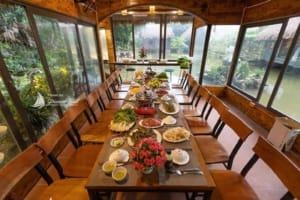






Recent Comments